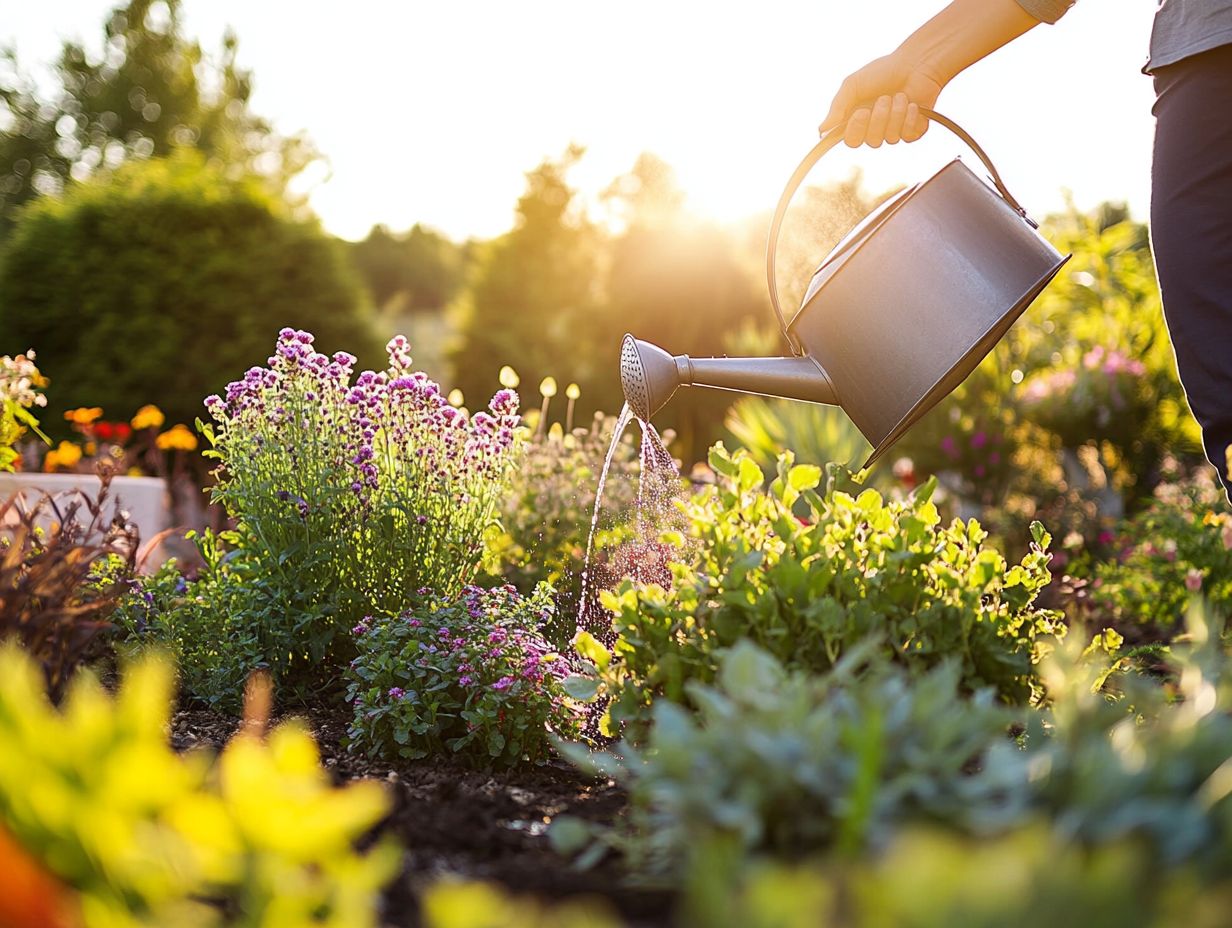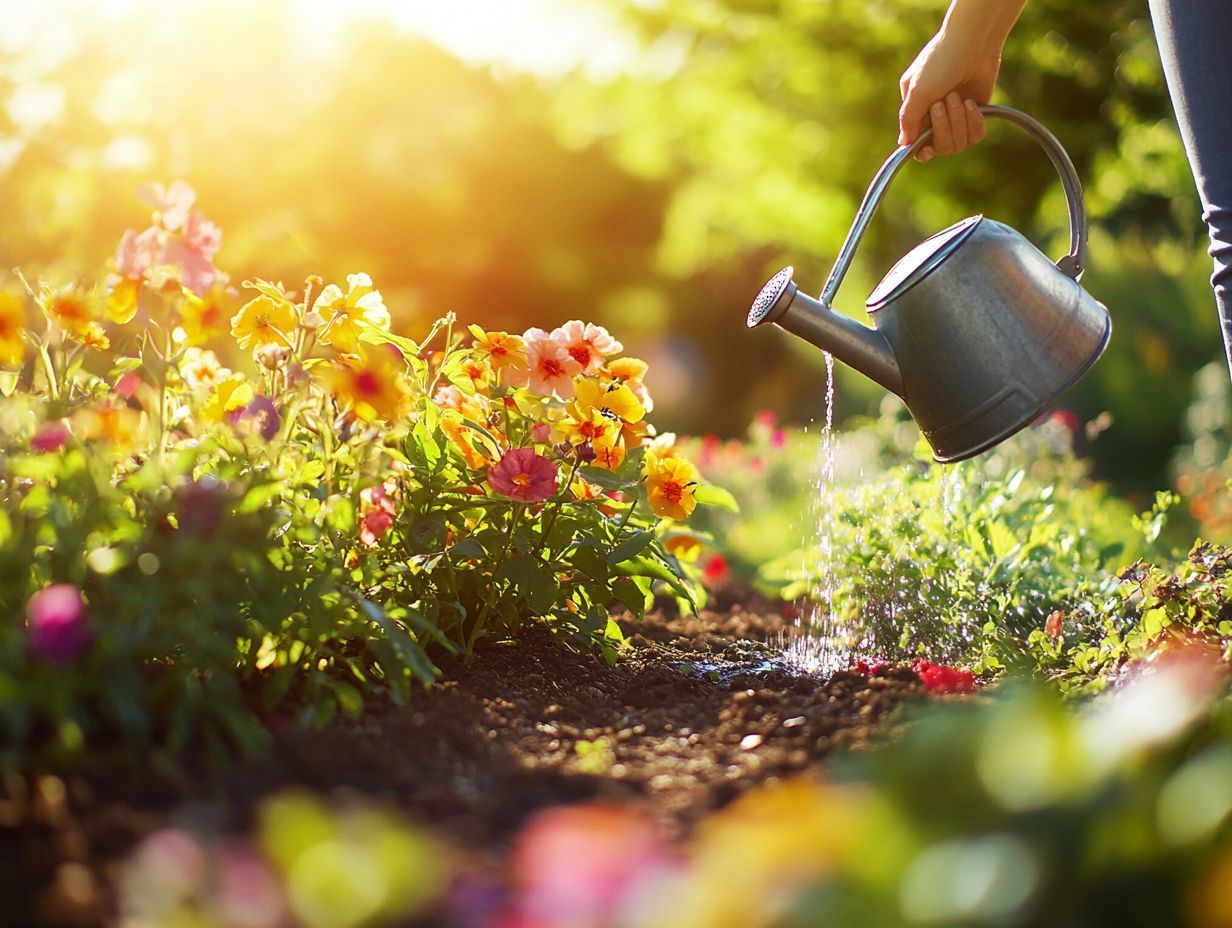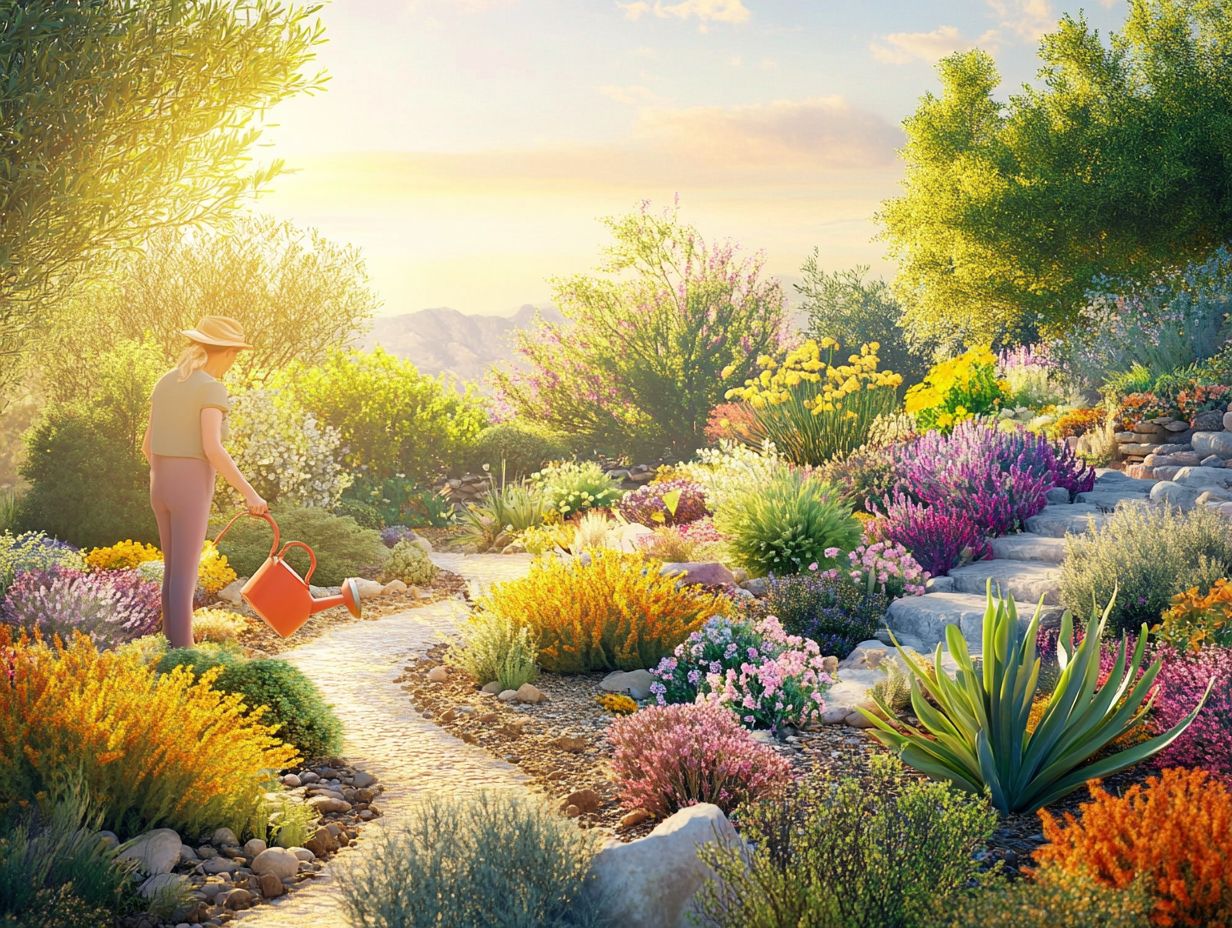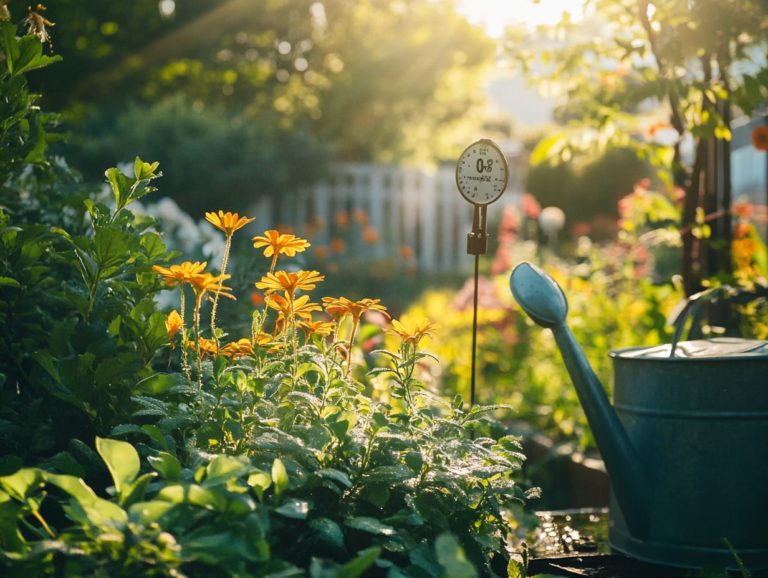5 Tips for Watering in Dry Climates
Watering plants in dry climates can present a challenge, but with the right strategies, you can cultivate a thriving garden.
This article unveils five effective tips to help you conserve water while maintaining the health of your plants. It emphasizes water conservation and proper mulch usage. From employing drip irrigation systems to timing your watering wisely, each tip provides unique advantages designed for arid environments.
Delve into the significance of mulching, the benefits of plant grouping, including raised beds, and the practicality of rain barrels.
Discover how to make every drop count in your garden!
Contents
- Key Takeaways:
- 1. Use Drip Irrigation Systems
- 2. Water in the Early Morning or Late Evening
- 3. Mulch Your Plants
- 4. Group Plants with Similar Water Needs
- 5. Invest in a Rain Barrel
- What Are the Main Challenges of Watering in Dry Climates?
- Frequently Asked Questions
- What are the best tips for watering in dry climates?
- How often should I water in a dry climate?
- What’s the best time of day to water in a dry climate?
- Why is mulching important for watering in dry climates?
- Can I use a sprinkler to water in a dry climate?
- How should I adjust my watering during drought conditions?
Key Takeaways:

- Invest in a drip irrigation system to efficiently water your plants and prevent wastage.
- Water your plants in the early morning or late evening to reduce water loss due to evaporation.
- Mulching your plants conserves water by reducing evaporation and improving soil moisture retention.
1. Use Drip Irrigation Systems
Implementing drip irrigation systems is an exceptional strategy for managing water resources in your garden, particularly in dry climates like California and Arizona. In these regions, where water conservation is crucial due to limited rainfall and prolonged droughts, drip irrigation shines.
It delivers water directly to the roots of your thirsty plants, minimizing waste and maintaining consistent soil moisture levels essential for keeping your garden healthy in arid conditions. This method not only conserves water but also encourages deep watering, allowing your plants to thrive.
The ability to customize water delivery effectively supports the growth of drought-resistant plants, which are species specifically adapted to survive with minimal water. You can elevate your watering game by integrating auto-watering systems, which are devices that automatically deliver water, ensuring your plants receive the precise amount of moisture they need.
To install successfully, take the time to map out your garden layout and select appropriate emitters, or devices that distribute water, that cater to the specific needs of each plant. Regular maintenance is key; checking for clogs and ensuring proper pressure settings can significantly enhance your system’s longevity and efficiency. This makes drip irrigation a reliable choice for sustainable gardening in regions where water resources are scarce.
2. Water in the Early Morning or Late Evening
Watering your garden in the early morning or late evening is an essential tip that helps you conserve water while maintaining optimal soil moisture levels. This is particularly important in dry climates like California and Arizona, where high temperatures can lead to rapid evaporation.
By choosing these times, you ensure that the water penetrates deep into the soil, promoting healthier plants and minimizing waste. This method significantly reduces evaporation rates because the cooler temperatures during these periods allow water to soak into the ground before the sun s heat can draw it away.
Watering at these times enhances absorption by plant roots, ensuring that moisture reaches them efficiently, which is vital for overall plant health. For those interested in improving their watering methods, exploring unique watering techniques for exotic plants can be beneficial. In regions prone to drought, adopting such practices reinforces sustainable water management strategies, enabling you to cultivate a thriving garden while being mindful of conserving precious water resources.
3. Mulch Your Plants
Applying mulch around your plants is not just a good idea; it’s essential for effective landscaping especially in dry climates like California. It helps conserve water, keeps the soil moist, and suppresses pesky weeds that compete for the resources your plants crave.
Choose organic mulch like wood chips or shredded leaves. This enriches the soil while helping helpful tiny organisms thrive. Aim for a mulch layer of 2-4 inches for optimal moisture retention, but refresh it regularly to maintain its weed-controlling powers.
Beyond its practical advantages, mulch creates a stunning landscape while keeping soil temperatures consistent a real win during sweltering heatwaves.
Selecting the right type of organic mulch be it shredded leaves, grass clippings, or bark allows you to customize the benefits to suit your gardening needs and enhance weed control.
4. Group Plants with Similar Water Needs

Group plants with similar water needs. This is a fundamental principle in effective landscape design, especially in dry climates where managing water is crucial for a vibrant garden.
When you arrange drought-tolerant plants alongside those needing more moisture, you can optimize your watering schedules. This ensures each plant receives the right amount of water without excess waste, promoting healthier growth and reducing overall water consumption.
Understanding these water requirements can lead to visually stunning arrangements. For instance, incorporating drought-resistant species like lavender, succulents, or native grasses creates breathtaking displays in arid environments while demanding minimal upkeep.
By categorizing plants based on moisture needs, you design layouts that enhance visual appeal while simplifying maintenance. Creating zones where drought-tolerant plants are grouped together allows for targeted irrigation and encourages the use of mulch, which retains soil moisture.
This strategic planning not only conserves water efficiently but also nurtures a thriving ecosystem, benefiting both you as a gardener and the environment.
5. Invest in a Rain Barrel
Get a rain barrel today it’s a game-changer for sustainable gardening! Especially in water-scarce regions like California and Arizona, where every drop counts during dry spells. These barrels collect and store rainwater, providing you with an eco-friendly resource for irrigation and plant care.
When you capture rainwater from your roof, you re not just saving water; you re minimizing surface runoff, which helps reduce erosion and filters out pollutants before they reach our waterways.
With various sizes and materials available, you can easily find a rain barrel that fits your outdoor aesthetic. Position it under a downspout for maximum efficiency and add a screen to keep out debris and insects.
Once your rain barrel is full, you can effortlessly use that collected water for watering your gardens and landscapes. This approach not only promotes sustainable landscaping but also contributes to a healthier environment, making you a conscientious steward of nature s resources.
What Are the Main Challenges of Watering in Dry Climates?
Watering in dry climates comes with its own set of challenges that demand careful planning and adaptable solutions, especially in regions like California and Arizona. Prolonged drought conditions and unpredictable weather patterns like those shaped by El Ni o can complicate traditional watering practices.
You’ll face key hurdles, such as maintaining adequate soil moisture, selecting the right irrigation methods, and choosing drought-tolerant plants that can flourish with limited water. To effectively overcome these challenges, learn how to adapt your watering in different climates. These obstacles can significantly impact your landscaping efforts, leading to stressed plants or, in the worst cases, total garden failures.
Without consistent moisture, soil can dry out quickly. It s crucial to implement effective irrigation techniques. Drip irrigation systems, which send water directly to the roots, reduce waste and enhance absorption an invaluable approach in tough conditions.
Adopting deep watering strategies encourages your plants’ roots to dig deeper into the soil, boosting their drought resistance. Don’t overlook water conservation methods; for example, mulching effectively retains soil moisture. Xeriscaping means designing gardens that need little or no water. Additionally, consider these tips for watering during winters. By embracing these practices, you can pave the path toward sustainable gardening in arid environments.
How Does Drip Irrigation Work and Why Is It Beneficial?
Drip irrigation operates by delivering a consistent supply of water right to the root zones of your thirsty plants through a network of tubing and emitters. This method stands out as one of the most efficient ways to manage water in landscaping.
With its targeted approach, you conserve water and boost soil moisture levels, ensuring that each plant receives just the right amount of hydration without excess runoff or evaporation. At the core of this system are various components, including mainlines, submain lines, and strategically placed emitters that release water slowly and consistently.
By adopting drip irrigation, you can significantly reduce your water usage, leading to healthier plants and improved growth rates. This method shines in regions with limited water resources, as it minimizes waste and allows for precise control over watering schedules, making it ideal for both residential gardens and large agricultural settings.
What Are the Benefits of Watering in the Early Morning or Late Evening?

Watering in the early morning or late evening can elevate your plant care routine in remarkable ways. By choosing these cooler times, you reduce evaporation rates, enhance soil moisture retention, and improve overall water conservation especially vital for drought-tolerant plants. This timing maximizes the water available to your plants while minimizing waste.
This practice ensures that water penetrates deeper into the soil, effectively nourishing root systems, and helps prevent fungal diseases that can arise when foliage stays wet overnight. During peak sun hours, the intensity of sunlight can lead to significant evaporation, rendering your watering efforts less effective.
If you re caring for specific plant types, such as succulents or those that require less frequent irrigation, adjust your timing and frequency according to their unique water needs.
By implementing these strategies, you re not just watering you re cultivating a sustainable approach to gardening that fosters healthier, more resilient plant growth.
Benefits of Watering in the Early Morning or Late Evening:
- Reduces evaporation rates
- Enhances soil moisture retention
- Prevents fungal diseases
Don t wait! Start watering in these cooler times for the best results!
How Does Mulching Help Conserve Water?
Mulching is a powerful technique for conserving water in your landscaping. It effectively retains soil moisture by reducing evaporation. At the same time, it keeps pesky weeds at bay that compete for those precious resources.
Opting for organic mulch, such as bark or straw, brings extra perks by enriching the soil with nutrients as it decomposes. This fosters a healthier environment for your plants.
The science behind mulch is quite fascinating. It creates a protective barrier that shields the soil from direct sunlight, which in turn slows down the rate of moisture evaporation.
When considering the right type of mulch, think about factors such as your local climate, the specific area of application, and the unique needs of your plants. For example, wood chips are fantastic for moisture retention and deliver a pleasing aesthetic. Meanwhile, straw works wonders in vegetable gardens due to its quick decomposition.
To truly harness the water conservation benefits of mulch, aim for a layer of 2 to 4 inches around your plants. This not only suppresses weed growth but also cultivates a favorable environment for beneficial microorganisms that enhance soil health.
Why Is Grouping Plants with Similar Water Needs Important?
Grouping plants with similar water needs is essential for efficient resource management in your landscaping efforts. This approach allows you to tailor your watering methods, optimizing water usage while enhancing plant health.
By understanding the water requirements of various species, you can effectively combine drought-tolerant plants with those that thrive on higher moisture. This ensures each plant receives the care it deserves while minimizing waste.
This strategic practice not only conserves water but also cultivates a more harmonious garden environment. For instance, pairing lavender, which flourishes in arid conditions, with ferns that crave moist soil can create competition and stress for both plants.
Instead, consider combinations like succulents alongside native grasses, as this promotes healthy growth and simplifies maintenance.
When planning your garden layout, think about grouping plants like tomatoes, which need more water, with basil, which thrives in similar moisture levels. This thoughtful organization maximizes watering efficiency and elevates the overall aesthetic appeal of your garden.
What Are the Advantages of Using a Rain Barrel?
Using a rain barrel offers you a wealth of benefits for water conservation, especially if you live in areas like California or Arizona. Collecting and storing rainwater allows you to embrace eco-friendly irrigation practices that lessen your dependence on municipal water sources and promote responsible water management.
This sustainable approach is invaluable for anyone looking to enhance their landscaping while reducing their environmental footprint. With a rain barrel, you can significantly cut down on your water bills, particularly during those dry spells when outdoor watering is essential.
Capturing rainwater doesn t just save you money; it also helps mitigate stormwater runoff, lowering the risks of flooding and erosion in your yard.
The best part? Installing a rain barrel is a breeze! You simply position it beneath a downspout and make the necessary adjustments to redirect that precious rainwater into your new container.
To effortlessly integrate this collected water with your existing irrigation system, easily attach a soaker hose or a drip irrigation setup. This way, your plants receive just the right amount of moisture without wasting any valuable resources.
Frequently Asked Questions

What are the best tips for watering in dry climates?
- Water deeply and infrequently to encourage deep root growth.
- Time your watering for early morning or late evening to reduce evaporation.
- Use mulch to retain moisture and prevent weed growth.
- Consider using drip irrigation or soaker hoses for targeted watering.
- Adjust watering frequency based on weather conditions and plant needs.
Ready to start mulching? Your garden will thank you!
How often should I water in a dry climate?
In a dry climate, how often you water depends on your plants, soil, and weather. As a general rule, water deeply but less often about 1 to 2 times a week.
What’s the best time of day to water in a dry climate?
Water early in the morning or late in the evening. This timing helps prevent evaporation and keeps your plants healthy.
Why is mulching important for watering in dry climates?
Mulching retains soil moisture and cuts down on evaporation. It also stops weeds from stealing water and nutrients from your plants.
Can I use a sprinkler to water in a dry climate?
Sprinklers might look easy, but they waste water through evaporation. Instead, try using drip irrigation or soaker hoses to target the roots directly.
How should I adjust my watering during drought conditions?
During a drought, be smart about your water use. Water less often and choose plants that can handle the dry conditions. You can also collect rainwater to help.






